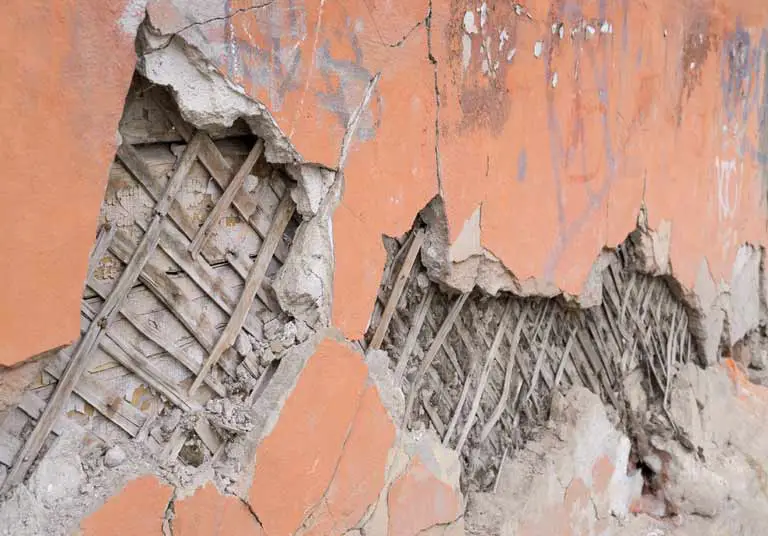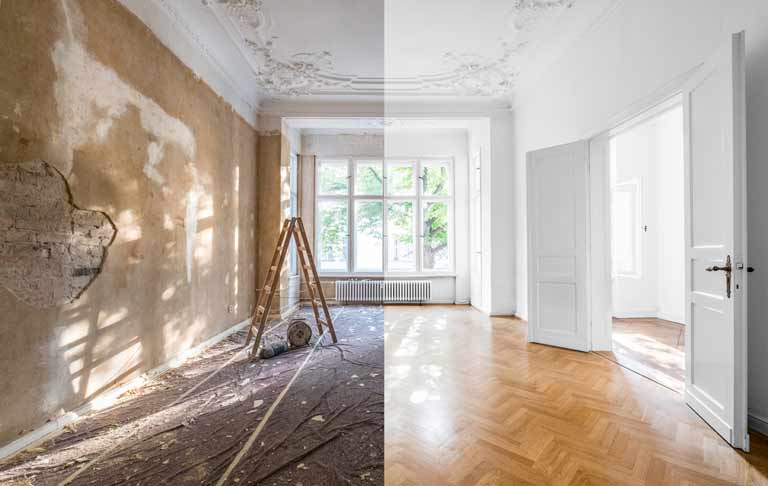
If you live in an older property, you may have noticed dust coming from the walls. This is particularly common in homes with lime plaster walls. Lime plaster is commonly used in older homes, and while it has many benefits, it can also be a source of dust that can harm your health.
When old and crumbly lime plaster is disturbed, it can release dust particles into the air. This dust can contain various potentially harmful dust like silica and lime dust. Silica can cause lung damage and respiratory problems, and lime dust is alkaline in nature, which can cause skin, eye and respiratory irritation.
If you are planning to carry out renovations or repairs in an older property with lime plaster walls, it is important to take the necessary precautions to protect yourself from dust exposure. This may include wearing a mask, using a dust extractor, and ensuring the work area is well-ventilated. It is also important to take care while cleaning up the debris as this, too, will agitate dust.
What is Lime Plaster?
If you own an old house, you may have heard of lime plaster. Lime plaster is a traditional building material used for thousands of years. It is made by mixing sand, water, and lime, usually non-hydraulic lime (also known as slaked lime, high calcium lime, air lime, fat lime or lime putty). It is breathable, meaning moisture can pass through it, unlike denser cement or polymer-based renders and plasters.
Lime plaster is eco-friendly and sustainable. It is a popular choice for restoration projects because it is compatible with older buildings and can help to prevent damp issues. Lime plaster is also a flexible material that can accommodate building movement without cracking. It is a durable material that can last many years if maintained properly.
Old plasters are generally made with lime and sand, adding animal hair to provide extra strength and reduce shrinking and cracking. Sometimes in high-status work, it is gauged with gypsum. Old and even ancient lime plaster often contained horsehair for reinforcement and pozzolan additives to reduce the working time.
Related article: How Many Coats of Lime Plaster is Best?
Hazards of Lime Plaster Dust
Health Hazards
If you are working with old lime plaster, it is important to know the potential health hazards associated with the dust it can produce. Lime plaster dust can contain harmful materials such as silica, lime dust, and even mould spores. Silica dust, in particular, can cause serious lung diseases such as silicosis, lung cancer, and chronic obstructive pulmonary disease (COPD).
Exposure to these hazardous materials can occur through inhalation of the dust or by skin contact. It is important to take precautions to minimize the risk of exposure, such as wearing appropriate personal protective equipment (PPE), including respiratory protection, gloves, and protective clothing. It is also important to ensure that the work area is well-ventilated to minimize the amount of dust in the air.
Environmental Hazards
In addition to the potential health hazards associated with lime plaster dust, there are also environmental hazards to consider. Lime plaster is a breathable material, which means that it allows moisture to pass through it. As lime ages over hundreds of years, it may begin to crumble. At this stage, it should be replaced because as the plaster crumbles, it gives off dust.
If you are working with lime plaster, it is important to take steps to minimize the spread of dust. This can include using dust suppression techniques such as wetting down the plaster before working with it, using dust extraction systems, and sealing off the work area to prevent dust from spreading to other parts of the building.
How to Handle Lime Plaster Dust
If you are working on a project involving old lime plaster, taking precautions when handling the dust is important. Lime plaster dust can be harmful if inhaled, so taking steps to protect yourself and those around you is important. Here are some precautions to take and tips for cleaning up lime plaster dust.
Precautions to Take
When working with old lime plaster, wearing protective clothing and equipment is important to avoid inhaling the dust. Here are some precautions to take:
- Wear a dust mask to protect your lungs
- Wear safety goggles to protect your eyes
- Wear gloves to protect your skin
- Wear a hat to keep the dust out of your hair
- Wear long sleeves and trousers to cover your skin
Cleaning Up Lime Plaster Dust
After you have finished working with old lime plaster, it is important to clean up the dust to prevent it from spreading and causing harm. Here are some tips for cleaning up lime plaster dust:
- Wet the dust down with water before cleaning it up to prevent it from becoming airborne
- Use a vacuum with a HEPA filter to clean up the dust
- Wipe down surfaces with a damp cloth to remove any remaining dust
- Dispose of any dust and debris in a sealed container
By taking these precautions and cleaning up the dust properly, you can help protect yourself and those around you from the harmful effects of lime plaster dust.

Is Old Lime Plaster Bad for the Environment?
If you’re concerned about the environmental impact of old lime plaster, you’ll be pleased to know that it’s actually a very eco-friendly building material. Lime plaster is made from natural materials and is free from synthetic additives, making it a sustainable and environmentally friendly choice for your home.
One of the top benefits of lime plaster is its carbon-absorbing properties. As it absorbs carbon, it can eventually become carbon neutral. This means that lime plaster can help reduce the amount of carbon in the atmosphere, making it a great choice for those looking for ways to reduce their carbon footprint.
Lime plaster is also vapour permeable, which means that it allows the building to breathe. This is important because it helps to prevent moisture build-up, which can lead to damp and mould problems. Lime plaster helps keep your home dry and healthy by allowing moisture to escape.
Another benefit of lime plaster is that it is long-lasting. Because it is breathable and flexible, lime plaster can protect the building without breaking down and cracking like brittle cement and gypsum plasters. This means that you won’t need to replace your lime plaster as often as you would with other types of plaster, which is good news for both your wallet and the environment.
Is Old and Crumbling Lime Plaster Toxic?
If you have an older property, you may have noticed that the plaster on the walls is starting to crumble and produce dust. This can be a cause for concern, especially if you are worried about the potential health risks of breathing in dust from old lime plaster.
Firstly, it is important to understand that lime plaster is not toxic in itself. It’s made from natural materials such as lime, sand, and water, and it contains no harmful chemicals. However, if the plaster is old and crumbling, it can produce dust that could be harmful if inhaled in large quantities.
It is important to take precautions when working with old and crumbling lime plaster. You should wear a dust mask and protective clothing to prevent inhalation of dust particles. It is also a good idea to wet the plaster before working with it to help reduce the amount of dust produced.
How Should Old Lime Plaster be Disposed of Once Removed?
Removing old lime plaster can be a messy and dusty process, and it’s important to dispose of the waste properly to avoid any health or environmental hazards. Here are some tips on how to dispose of old lime plaster:
- Remove the plaster in small parts using a pry bar and trowel to minimize dust.
- Wear gloves and a dust mask to protect yourself from any harmful particles.
- Place the old plaster in heavy-duty trash bags, and seal them tightly to prevent any dust or debris from escaping.
- Contact your local waste management facility to find out if they accept construction waste and, if so, what their requirements are for disposal.
- If your waste management facility does not accept construction waste, consider hiring a professional waste removal service to dispose of the plaster for you.
Additionally, did you know that old lime plasters can actually be recycled and used in new ones? The plaster must be crushed and sometimes graded to produce a sand-like aggregate. This aggregate can be mixed with fresh, high-quality sand with fresh lime, either hydraulic or non-hydraulic. This not only saves on waste but also helps preserve the original fabric of the building!
By following these tips, you can safely and responsibly dispose of old lime plaster and keep your environment clean and healthy.
Conclusion
If you are dealing with old lime plaster in your home, it is important to take necessary precautions to avoid exposure to harmful dust. While lime plaster itself is not considered hazardous, the dust created during removal or renovation can be dangerous to your health.
It is important to wear protective gear, such as a mask, gloves, and goggles when working with or around old lime plaster. This will help to prevent the inhalation of dust particles, which can cause respiratory irritation or other health problems.
If you are unsure whether your old lime plaster contains asbestos or other hazardous materials, it is best to consult a professional before attempting any removal or renovation work. They can assess the situation and provide guidance on how to proceed safely.
Related article: Does Lime Plaster Contain Asbestos?
Additionally, if you plan to apply new lime plaster over old plaster, it is important to ensure that the old plaster is in good condition and not loose or damaged. If it is, it should be removed before applying new plaster.
Overall, while old lime plaster itself is not considered hazardous, it is important to take necessary precautions when working with or around it to avoid exposure to harmful dusFollowinging proper safety procedures and consulting with professionals when necessary can ensure a safe and successful renovation or restoration project.

